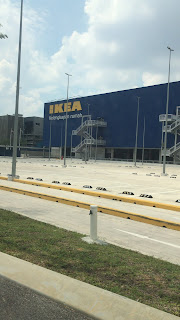Definitely A Cracking Good Crab
Let's learn about Horse-shoe Crab or Belangkas today! :)
-------------------------------------
Publication:
NST
Date
of publication: Mar 16, 2009
Byline
/ Author: By Evangeline Majawat
Definitely A Cracking Good Crab
MYSTERIOUS
and unappreciated, horseshoe crabs are slowly revealing their secrets to a team
of local scientists. EVANGELINE MAJAWAT discovers that their findings could
just be the `eureka' moment the nation has been holding her breath for.
With
its primitive armour-like shell and spiny tail, this misunderstood marine
creature strikes fear in the hearts of many.
But
one of nature's gentlest creatures, the horseshoe crab could just be the
nation's key to breakthrough research into an exclusive multi-million
biomedical industry currently dominated by one country.
For
the past few years, horseshoe crabs or "belangkas" have been the
subject of intense but low-profile research at Universiti Malaysia Terengganu
(UMT).
The
eight-man team has been studying two out of three species of Asian horseshoe
crabs found in our waters - Tachypleus gigas and Carcinoscorpius rotundicauda -
in the hope of discovering a way to produce an endotoxin test kit.
If
successful, Malaysia would be the second country in the world and the first in
Asia to produce a test kit derived from the famous cyan-blue blood of horseshoe
crabs.
More
importantly, this test kit would be an alternative to the invaluable endotoxin
test "Limulus Amebocyte Lysate" (LAL), which is produced only in the
United States.
The
prototype is expected to be ready by the end of this year, with the end product
completed by 2010.
"We're
on the brink of a great breakthrough. If we do produce this kit, then we won't
have to pay so much any more (for LAL)," UMT Institute of Tropical
Aquaculture senior researcher Dr Zaleha Kassim told the New Straits Times.
The
LAL is the standard test used by laboratories and hospitals worldwide to detect
harmful bacteria and endotoxins in all pharmaceutical products and medical
devices.
"We
would cut cost for local labs and hospitals. And Malaysia could potentially
make a lot of money if this test kit gets into the market," Zaleha said.
Fellow
UMT Biological Science Department senior researcher Dr Noraznawati Ismail
believes that the local test kit would cost only half the price of the imported
ones.
"It
generally costs more than RM1,000 for just a minute amount of LAL. We could
produce local kits which would be sold for half that sum."
In
December last year, UMT received a RM1.9 million research grant from the
Science, Technology and Innovation Ministry (Mosti).
UMT
was given two years to study and develop a scientific protocol for the
extraction of the blood compounds and production of the endotoxin test kit.
The
kit would be called either "Tachypleus Amebocyte Lysate" (TAL) or
"Carcinoscorpius Amebocyte Lysate" (CAL), after the genus of the two
types of horseshoe crabs.
"We're
in the midst of refurbishing the existing lab in UMT so we can concentrate on
studying these animals," Noraznawati said.
The
team is eager to extend the research to Sabah waters where the biggest of the
Asian horseshoe species, the Tachypleus tridentatus, thrives.
Zaleha
said a separate team of researchers were in the midst of conducting a stock
assessment study with Mosti and the Agriculture and Agro-based Industry
Ministry.
She
said they hoped to start work in Sabah in the middle of this year.
"We're
on the verge of discovering something very important," she said proudly.
------------------------
Pollution,
greedy fishermen a threat to horseshoe crab
ONCE
considered useless, the humble "belangkas" is thrust into the
limelight as more people discover the beneficial properties of its blood.
But
the attention is not always welcomed because with it, comes unsustainable
demand and irresponsible fishing.
Universiti
Malaysia Terengganu Institute of Tropical Aquaculture senior researcher Dr
Zaleha Kassim said the price of a horseshoe crab had skyrocketed from a mere 50
sen to a gut-punching RM5.
This,
she said, had given rise to fly-by-night companies and greedy fishermen who
were all in for the quick buck.
Zaleha
has had to change her mobile phone number after being bombarded with calls from
parties demanding she buy their catch.
"I
can't stand these people who demand that the university buy from them. When we
refuse, they'll blame us. We only need a small amount. These people call us and
force us to buy up to hundreds of horseshoe crabs," she said.
Most
of the time, these horseshoe crabs are found to be in poor condition.
"Then,
there are those who call us for advice on how to rear horseshoe crabs. They
cannot be cultivated.
"Most
of them die in captivity within two to three months of being caught," she
said.
She
also explained that it takes up to nine years for a horseshoe crab to mature
sexually and be able to mate.
"There
is no quick get-rich-scheme with these horseshoe crabs."
Zaleha
said the UMT research team would not only draw up the scientific protocol for
their blood extraction but also for the conservation of these "beautiful
and gentle creatures".
"Not
much is known about horseshoe crabs. They're not a protected species but don't
be fooled into thinking that they are abundant in our waters.
"It
is very important that we protect them from unsustainable fishing. This would
ensure our supply if the research is successful," she said.
There
are also threats from habitat destruction and pollution.
"As
mangrove forests disappear and beaches and the sea are polluted, the number of
these animals will dwindle," she said.
Horseshoe
crabs are also important for migratory birds.
"Horseshoe
crabs are food source for migratory birds which flock to the country every
year. If we protect the crabs, then the birds come with the bird watchers in
tow. Now, isn't that eco-tourism?"
Zaleha
also dismissed talk that consuming horseshoe crab meat has traditional
medicinal benefits.
"It
is not scientifically proven," she pointed out.
__________________________________________________
© Copyright 2009 The New Straits Times Press (M) Berhad. All rights reserved.
Credits to: New Straits Times (NST)


Comments